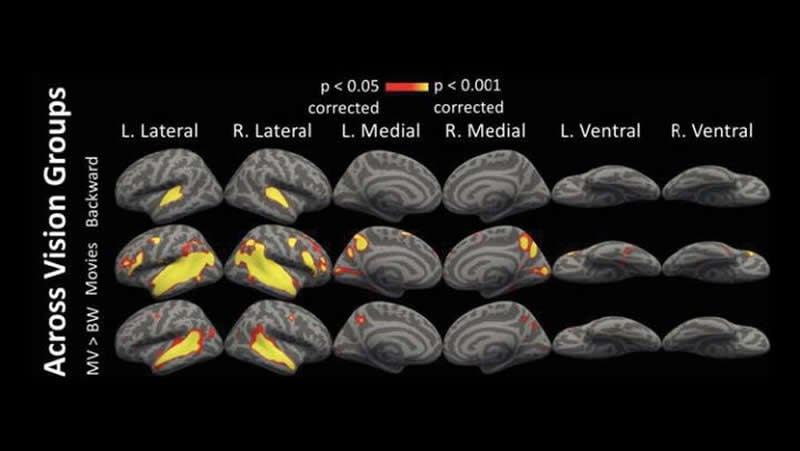Summary: There is an underlying organization that dictates how the visual cortex is repurposed in blind people, which is not random.
Source: SfN
In adults that are born blind, the “visual” cortex is activated in a similar way during a listening task, according to new research in Journal of Neuroscience. The results answer questions about how development can override anatomy to influence brain function.
Previous research observed that the “visual” cortex in blind people is recruited for other functions, but it was not known if the new purpose was consistent or varied from person to person.
Loiotile et al. used functional magnetic resonance imaging to compare how the auditory and visual cortices of the brain were activated in blind and blindfolded, sighted participants while listening to audio clips from movies. Sixty-five percent of the regions in the visual cortex had similar activation among the blind participants when they listened to the movie clips.

The similarity diminished when the sentences were played in a random order or the track was played backwards, indicating that the region is used for higher-order processing.
These results suggest that there is an underlying organization that dictates how the visual cortex is repurposed in blind people, and that it is not random.
Source:
SfN
Media Contacts:
David Barnstone – SfN
Image Source:
The image is credited to Loiotile et al., JNeurosci (2019).
Original Research: Closed access
“Naturalistic Auditory Stories Synchronize “Visual” Cortices Across Congenitally Blind but Not Sighted Individuals”. Rita Loiotile, Rhodri Cusack and Marina Bedny.
Journal of Neuroscience doi:10.1523/JNEUROSCI.0298-19.2019.
Abstract
Naturalistic Auditory Stories Synchronize “Visual” Cortices Across Congenitally Blind but Not Sighted Individuals
How does developmental experience, as opposed to intrinsic physiology, shape cortical function? Naturalistic stimuli were used to elicit neural synchrony in individuals blind from birth (n=18) and those who grew up with sight (n=18). Blind and blindfolded sighted participants passively listened to three audio-movie clips, an auditory narrative, a sentence shuffled version of the narrative (maintaining language but lacking a plotline), and a version of the narrative backwards (lacking both language and plot). For both groups, early auditory cortices were synchronized to a similar degree across stimulus types, while higher-cognitive temporo-parietal and prefrontal areas were more synchronized by meaningful, temporally extended stimuli (i.e., audio-movies and narrative). “Visual” cortices were more synchronized across blind than sighted individuals, but only for audio-movies and narrative. In the blind group, “visual” cortex synchrony was low for backwards speech and intermediate for sentence shuffle. Meaningful auditory stimuli synchronize “visual” cortices of people born blind.
SIGNIFICANCE STATEMENT
Naturalistic stimuli engage cognitive processing at many levels. Here, we harnessed this richness to investigate the effect of experience on cortical function. We find that listening to naturalistic audio-movies and narrative drives synchronized activity across “visual” cortices of blind, more so than sighted, individuals. “Visual” cortex synchronization varies with meaningfulness and cognitive complexity. Higher synchrony is observed for temporally extended meaningful stimuli (e.g. movies/narrative), intermediate for shuffled sentences, lowest for time varying complex noise. By contrast, auditory cortex was synchronized equally by meaningful and meaningless stimuli. In congenitally blind individuals most of “visual” cortex is engaged by meaningful naturalistic stimuli.






